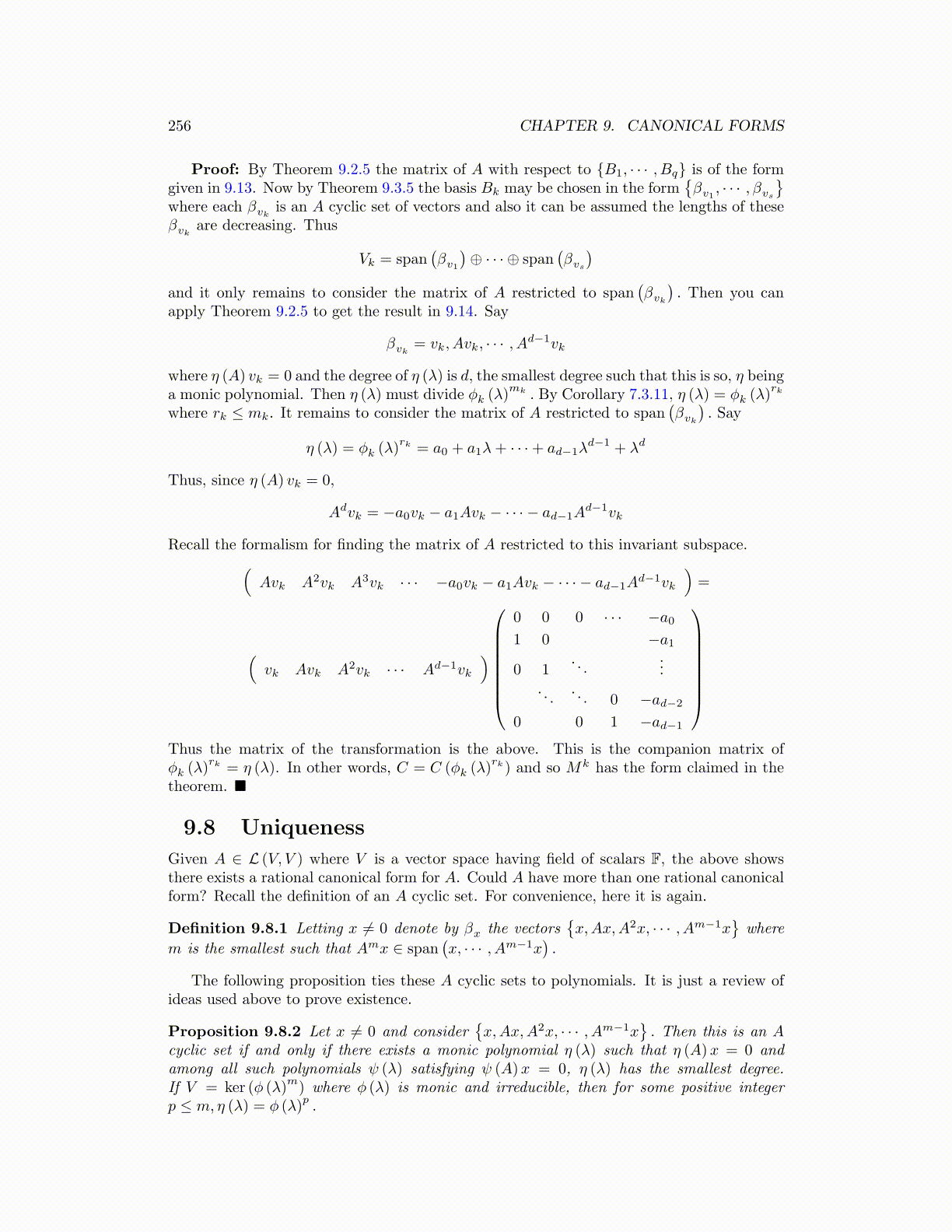
256 CHAPTER 9. CANONICAL FORMS
Proof: By Theorem 9.2.5 the matrix of A with respect to {B1, · · · , Bq} is of the formgiven in 9.13. Now by Theorem 9.3.5 the basis Bk may be chosen in the form
{βv1 , · · · , βvs
}where each βvk
is an A cyclic set of vectors and also it can be assumed the lengths of theseβvk
are decreasing. Thus
Vk = span(βv1
)⊕ · · · ⊕ span
(βvs
)and it only remains to consider the matrix of A restricted to span
(βvk
). Then you can
apply Theorem 9.2.5 to get the result in 9.14. Say
βvk= vk, Avk, · · · , Ad−1vk
where η (A) vk = 0 and the degree of η (λ) is d, the smallest degree such that this is so, η beinga monic polynomial. Then η (λ) must divide ϕk (λ)
mk . By Corollary 7.3.11, η (λ) = ϕk (λ)rk
where rk ≤ mk. It remains to consider the matrix of A restricted to span(βvk
). Say
η (λ) = ϕk (λ)rk = a0 + a1λ+ · · ·+ ad−1λ
d−1 + λd
Thus, since η (A) vk = 0,
Advk = −a0vk − a1Avk − · · · − ad−1Ad−1vk
Recall the formalism for finding the matrix of A restricted to this invariant subspace.(Avk A2vk A3vk · · · −a0vk − a1Avk − · · · − ad−1A
d−1vk
)=
(vk Avk A2vk · · · Ad−1vk
)
0 0 0 · · · −a01 0 −a1
0 1. . .
.... . .
. . . 0 −ad−2
0 0 1 −ad−1
Thus the matrix of the transformation is the above. This is the companion matrix ofϕk (λ)
rk = η (λ). In other words, C = C (ϕk (λ)rk) and so Mk has the form claimed in the
theorem. ■
9.8 Uniqueness
Given A ∈ L (V, V ) where V is a vector space having field of scalars F, the above showsthere exists a rational canonical form for A. Could A have more than one rational canonicalform? Recall the definition of an A cyclic set. For convenience, here it is again.
Definition 9.8.1 Letting x ̸= 0 denote by βx the vectors{x,Ax,A2x, · · · , Am−1x
}where
m is the smallest such that Amx ∈ span(x, · · · , Am−1x
).
The following proposition ties these A cyclic sets to polynomials. It is just a review ofideas used above to prove existence.
Proposition 9.8.2 Let x ̸= 0 and consider{x,Ax,A2x, · · · , Am−1x
}. Then this is an A
cyclic set if and only if there exists a monic polynomial η (λ) such that η (A)x = 0 andamong all such polynomials ψ (λ) satisfying ψ (A)x = 0, η (λ) has the smallest degree.If V = ker (ϕ (λ)
m) where ϕ (λ) is monic and irreducible, then for some positive integer
p ≤ m, η (λ) = ϕ (λ)p.